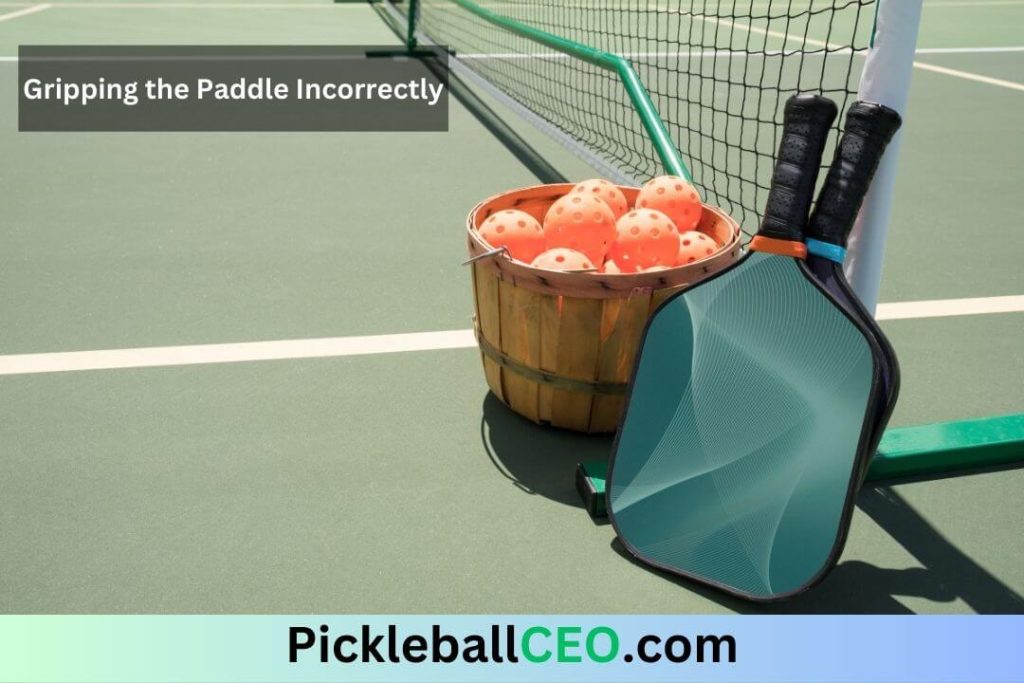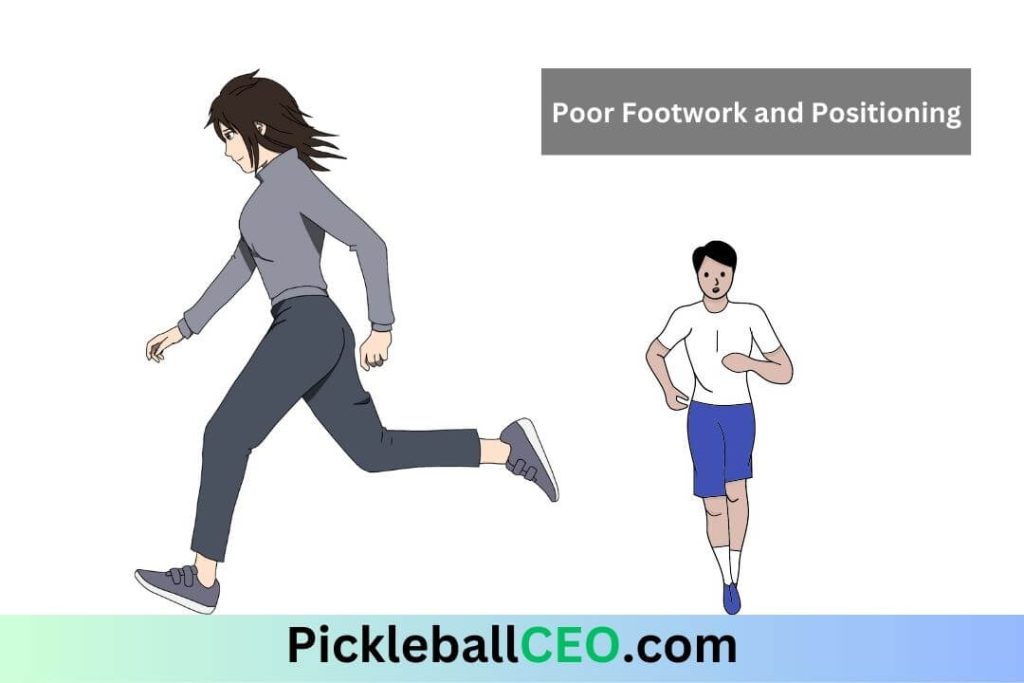Introduction: Backhand Shot
The backhand shot in pickleball is an essential stroke that can greatly impact your performance on the court. However, many players, especially beginners, often make common mistakes that can hinder their backhand effectiveness. In this article, we will highlight five common backhand mistakes pickleball players make and provide valuable tips to help you improve your backhand technique and elevate your game.
1. Gripping the Paddle Incorrectly


Gripping the paddle incorrectly can significantly impact your backhand shot. Let’s explore some common sub-mistakes related to grip and how to address them:
Gripping Too Tightly
One sub-mistake is gripping the paddle too tightly. A tight grip can lead to tension in your arm and wrist, limiting your range of motion and affecting the fluidity of your swing. To overcome this, consciously focus on loosening your grip. Imagine holding the paddle with a relaxed handshake-like grip, allowing your wrist to move freely during the swing. Practicing with a softer grip will improve your paddle control and enhance the consistency and power of your backhand shots.
Gripping Too Loosely
Conversely, holding the paddle too loosely can also result in backhand mistakes. A loose grip may lead to inconsistent contact with the ball and a lack of control. To address this, ensure your grip is firm enough to maintain control over the paddle while still allowing for wrist mobility. Experiment with different grip sizes and find the balance that provides both control and comfort. Remember, finding the right grip pressure is crucial for executing a successful backhand shot.
Grip Size and Shape
Another aspect to consider is the size and shape of your paddle grip. Grips come in various sizes and shapes, such as small, medium, or large, as well as square, rounded, or contoured. Choosing the right grip size and shape that matches your hand size and comfort can significantly improve your backhand stroke. Visit a local pickleball retailer or try different paddles with varying grip options to find the one that feels natural and comfortable in your hand.
By addressing grip-related issues and finding the optimal grip pressure and paddle shape, you can enhance your backhand technique and unlock its full potential on the pickleball court.
2. Poor Footwork and Positioning


Backhand mistakes often stem from inadequate footwork and positioning. Let’s delve into some sub-mistakes related to footwork and positioning and how to improve them:
Being Off-Balance
One sub-mistake is being off-balance while attempting a backhand shot. This can occur when your weight is not properly distributed or when you’re not maintaining a stable stance. To address this, focus on maintaining a balanced and stable position throughout the shot. Keep your feet shoulder-width apart, distribute your weight evenly, and bend your knees slightly for stability. This will help you generate power and maintain control over your backhand strokes.
Incorrect Positioning
Another sub-mistake is being in the wrong position when attempting a backhand shot. Positioning yourself appropriately in relation to the incoming ball is crucial for a successful backhand. Anticipate the ball’s trajectory and move your feet to adjust your positioning accordingly. Ideally, you want to be positioned with your body aligned with the ball’s path to ensure a clean contact. By focusing on proper footwork and positioning, you’ll be better prepared to execute a strong and accurate backhand shot.
3. Lack of Preparation and Timing
Failing to prepare and time your backhand shot correctly can lead to inconsistency and poor stroke execution. Consider the following sub-mistakes and tips to improve your preparation and timing:
Rushing the Shot
One sub-mistake is rushing the backhand shot without adequate preparation. Sometimes, players feel the need to react quickly and may not take enough time to set up for the shot. To overcome this, focus on maintaining a composed and controlled approach. As the ball approaches, take a moment to position yourself, set your feet, and prepare for the backhand stroke. This brief moment of preparation will significantly improve your shot execution.
Poor Ball Tracking
Another sub-mistake is losing sight of the ball or failing to track its movement effectively. Keep your eye on the ball throughout its flight, even during your opponent’s shot. By closely tracking the ball, you’ll have a better understanding of its speed, trajectory, and timing, allowing you to prepare your backswing and time your shot accurately. Practice ball tracking drills to sharpen your focus and improve your ability to anticipate the ball’s path.
By addressing poor footwork and positioning, and focusing on proper preparation and timing, you can significantly enhance your backhand technique in pickleball. Developing a stable and balanced stance, positioning yourself correctly, and taking the time to prepare and track the ball will lead to more consistent and powerful backhand shots, ultimately elevating your overall game on the pickleball court.
4. Insufficient Follow-Through
Completing a proper follow-through is crucial for a successful backhand shot. Let’s explore the importance of follow-through and how to improve it:
Incomplete Swing Path
One sub-mistake is having an incomplete swing path, stopping the swing prematurely after making contact with the ball. This can result in a lack of control and accuracy in your backhand shots. To enhance your follow-through, focus on extending your swing path beyond the point of contact. Allow your paddle to naturally continue its path, following through with your swing. This full follow-through helps maintain control and promotes better ball placement, leading to increased shot consistency.
Engaging the Wrist
Another aspect to consider is engaging your wrist during the follow-through. Many players tend to lock their wrist or keep it passive during the shot, which limits their ability to fully follow through. To improve this, consciously involve your wrist in the swing by allowing it to naturally hinge and extend during the follow-through. This active wrist movement adds fluidity to your shot and enhances your control and power.
5. Neglecting Backhand Practice
Neglecting dedicated practice for your backhand is a common mistake that can hinder your overall improvement. Here are some tips to address this:
Allocate Practice Time
To overcome the neglect of your backhand, allocate specific practice time to focus on improving this aspect of your game. Dedicate a portion of your practice sessions to backhand drills and exercises. By intentionally setting aside time for backhand practice, you can develop muscle memory, timing, and overall proficiency in this essential shot.
Backhand-Specific Drills
Incorporate drills that specifically target backhand shots into your practice routine. Cross-court rallies, where you consistently hit backhand shots to your opponent’s backhand, can help you refine your backhand technique. Defensive blocks that require quick backhand reactions are also valuable drills to enhance your backhand skills. Regularly engaging in these drills will improve your comfort and confidence with the backhand shot.
Focus on Muscle Memory and Timing
Consistent practice helps develop muscle memory and timing for your backhand. By repeatedly performing the shot in different scenarios and situations, you will become more familiar with its nuances and intricacies. This familiarity will enhance your ability to execute accurate and controlled backhand shots during real game situations.
By addressing the follow-through aspect and committing to dedicated backhand practice, you can significantly improve your backhand game in pickleball. Remember to focus on extending your follow-through, engaging your wrist, and practicing specific backhand drills to enhance your skills. With regular practice and a proactive approach, you can transform your backhand into a reliable and effective weapon, contributing to your overall success on the pickleball court.
Conclusion
Improving your backhand technique in pickleball requires addressing common mistakes and implementing effective strategies. By focusing on your grip, footwork, and positioning, you can enhance control and power in your backhand shots. Additionally, proper preparation, timing, and a complete follow-through will contribute to better shot consistency and accuracy. Don’t neglect backhand practice, dedicating specific time to drills that target this important stroke. With persistence and dedication, you can overcome these common backhand mistakes, elevate your backhand game, and become a more well-rounded and successful pickleball player on the court.







Comments (11)
6 Best Elongated Pickleball Paddles to power up Pickleballsays:
July 18, 2023 at 6:27 am[…] making it a versatile paddle for players of all styles. Its design and weight distribution enable players to generate impressive power behind their shots, allowing for aggressive play at the net and effective drives. At the same time, the paddle […]
30 to 40% Faster with This Pickleball Trick - Pickleball CEOsays:
July 19, 2023 at 11:33 am[…] shot execution, good court coverage, and an ability to anticipate opponents’ shots. A 4.0 player demonstrates a variety of shots, understands strategy, and can engage in competitive […]
5 Deceptive Pickleball Shots to Win Easy Points - Pickleball CEOsays:
July 21, 2023 at 11:27 am[…] around-the-post (ATP) shot is a jaw-dropping and deceptive shot that showcases the finesse and creativity of a skilled pic…. When the opportunity arises, the ATP shot can leave both opponents and spectators in awe of its […]
Mastering Pickleball: 10 Rules You Must Know for Successsays:
July 22, 2023 at 10:38 am[…] zone and hit a volley, except when the ball bounces in this area. Staying out of the NVZ prevents players from gaining an unfair advantage and encourages strategic shot […]
7 Strategies to Master the Pickleball Third Shot Dropsays:
July 22, 2023 at 10:51 am[…] the court. Targeting your opponent’s backhand side can put them at a disadvantage since most players are less comfortable hitting backhand shots. Alternatively, aiming for the center of the court can make it harder for your opponent to […]
3 of the Craziest Pickleball World Records - Pickleball CEOsays:
July 22, 2023 at 11:02 am[…] pickleball, players typically engage in quick, low-to-the-ground shots. However, one player took a different approach by attempting to hit the highest pickleball shot ever recorded. With precision and skill, this ambitious player launched the pickleball high […]
Mastering the 5 Pickleball Rules- Pickleball CEOsays:
July 22, 2023 at 11:06 am[…] leverage the two-bounce rule, players can employ strategies such as deep returns to force opponents back and create opportunities …. It also opens up possibilities for drop shots and dinks, which can catch opponents off […]
11 of the Best Pickleball Trick Shots This Weeksays:
August 8, 2023 at 9:40 am[…] two-handed backhand slice is a shot that adds variety to a player’s repertoire. This shot involves using both hands on the backhand side to slice the ball, causing it […]
Lob Shot in Pickleball: 11 Ways to Elevate Your Gamesays:
August 8, 2023 at 10:04 am[…] professional pickleball players can provide valuable insights into the lob shot technique. Watch matches, instructional videos, or attend live tournaments to gain a deeper […]
5 Ways Racquetball Skills Transfer to Pickleball - Pickleball CEOsays:
August 8, 2023 at 12:24 pm[…] players are familiar with manipulating shot angles to their advantage. They possess the knowledge of hitting cross-court shots, splats, […]
Debunking the Myth: Heavier Paddles Don't Guarantee More Power in Pickleball - Pickleball CEOsays:
August 8, 2023 at 5:11 pm[…] volley shots, where the ball is struck in mid-air without bouncing, are not allowed in the kitchen, players are permitted to hit groundstrokes or shots that bounce within the kitchen before being played. This means that hitting the ball from the […]